By Jeffrey A. Rendall, Photos By Jeff Janas
LAYTONSVILLE, MD -- The irresistible force vs. the immovable object. That's what it must feel like building a golf course these days -- at least in certain locations. It's the developers' organization and vision versus the dogged, regulation enforcing government bureaucracy. And while it's hardly a good against evil scenario, the competing forces' differing interests will tend to slow things up a bit.
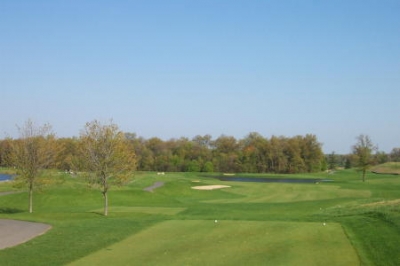 |
| The wide-open nature of Blue Mash is well-represented by the view from the 10th tee. |
According to Joe Hills (Golf Course Architect Arthur Hills' son), owner and operator of Blue Mash Golf Course, it took years to get things ironed out with the local permitting agencies in order to build the layout: "Shortly after I moved to the Washington, DC area in 1989, I realized that there was a tremendous undersupply of upscale public golf in the Capital region at that time -- and having been involved in the golf business for a few years previously, I wanted to get into the development and ownership side of the industry."
Hills continues, "Not really knowing where to start, I looked in the yellow pages and spotted a realtor's ad that mentioned land assemblage, so I gave him a try -- and that was the beginning of the Blue Mash odyssey."
For those who let their fingers do the walking, Hills' experience proves there could very possibly be gold (or should I say, 'blue') at the other end of a phone line.
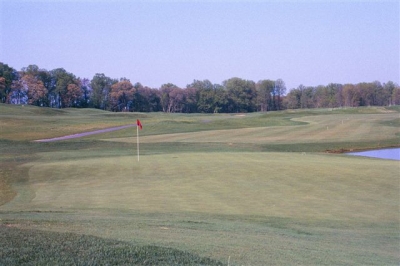 |
| The par five 9th is Blue Mash's #1 handicap hole. You've got water all down the left side, just waiting to gobble up a sliced surlyn treat. |
"To make a long story short, we ended up building Blue Mash on the farm owned by the gentleman who answered the phone. He possessed some farmland in Montgomery County, and I'd discovered a few weeks before that a special zoning ordinance had just been passed, allowing for golf courses by special exception in the County's Agricultural Preserve. Then, after three other golf course applications were filed within a few weeks, I heard the zoning exception was about to be repealed. We ended up filing our document at 4 o'clock the day before the exception was repealed, and our application was grandfathered in," Hills added.
Hills' success in finishing Blue Mash probably wouldn't rank as high as a stroke of genius, but it also can't be attributed to plain dumb luck, either. He saw an opportunity -- then his savvy, research skills, excellent memory and downright never-say-die attitude carried the day. Montgomery County is one of the wealthiest per capita districts in the United States, and there are certainly a good many folks who'd be willing to meet upscale asking fees for a quality daily fee course. And that's exactly what they've received.
The land's initial appearance didn't really provide it, however: "There was a landfill next door, power lines running through the center of the property, 200 foot buffer requirements around the borders -- a hundred different reasons for not doing it. But there was an inexorable force that kept moving me along," Hills said.
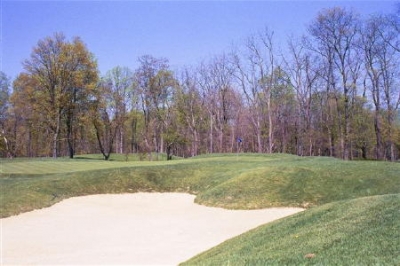 |
| Getting close to the 2nd green, you'll see the creative mounding that Arthur Hills dreamed up at Blue Mash. |
Perhaps that 'force' can be explained by Hills' father, Arthur, the designer of the course on his son's property: "Joe was a philosophy major in college, and there must have been something philosophical about the Blue Mash project, because it took an awful lot of perspective and persistence to go through what he did, and see it through to the end. It seemed like there was setback after setback, but he just kept moving forward."
The younger Hills said they went through seven years of bureaucratic nightmares trying to secure approvals, then their pre-development costs went through the roof, and finally, they were forced to add six more parcels of land to fill out the course and its boundaries. "It became one of the most complicated deals our lawyers had ever seen," Hills mused.
In addition to the on-paper difficulties of putting Blue Mash together, there was the property's historical significance. Again, Joe Hills elaborates: "We were required to conduct an archeological investigation, because it appeared as though there were some historic foundations on the property. They found out the land was once home to a freed slave settlement known as 'Blue Marsh,' because of the low lying wet land with clays of blue. Its colloquial pronunciation was 'Blue Mash,' and we just thought the name fit."
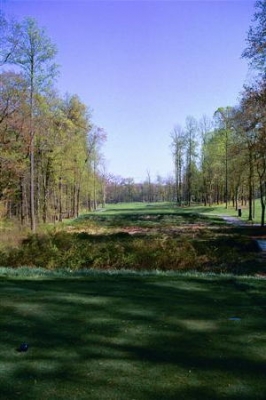 |
| Not so wide open here on the 7th tee. Pick a club you can hit straight, or get ready to meet nature face-to-face. |
There's a reason why all the persistence was worth it. The old saying 'good things come to those who wait' is certainly true for Blue Mash Golf Course. Though it surely won't overwhelm you with tremendous natural aesthetic beauty, the course is laid out in attractive shaping and formations -- resulting in a fair dose of challenge, mixed with the playability you'd expect from an Arthur Hills' designed layout.
Arthur describes it: "I think Blue Mash is a golf course that most all golfers can enjoy. For the better players, there's some challenge there -- but since it's relatively short (by today's standards, 6885 yards, par 71), maybe their goal should be to try and break 70. For your recreational players, there's such a variety of shots -- it's a golf course for people to enjoy playing golf."
Echoing the senior Hills' sentiments is Eric 'EB' Bickel, of 99.1 HFS's 'Sports Junkies' morning show, who joined us for the round: "Blue Mash is a really challenging and fun place to test your golf game. I particularly like its variety -- Arthur Hills designed some open holes, holes cut through the woods, and some water holes. There're short par 3's, long par 3's, a drive-able par four and a 480 yard par four, which is uphill and usually plays into the wind. There's also a par five that's reachable in two for even middle-length players. Overall, it's a fun test of golf, in a really great location with a friendly staff and first rate practice facilities."
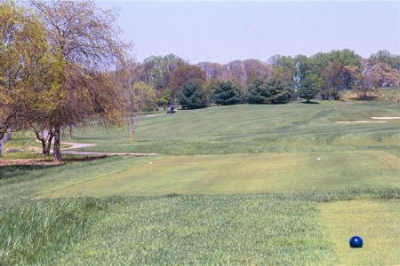 |
| You won't ease into your round at Blue Mash. The first hole is a 449 yard, dogleg right par four. |
Variety seems to be the theme, but don't take the experts' word for it. Glance at the scorecard, and you'll see what they mean -- a 580 yard par five (from the back tees), and a 500 yarder. A 478 yard par four, and a 310 yarder. A 217 yard par three, and a 160 yarder -- with varying distances of each par variety mixed in between.
It should be noted that the lion's share of tough holes hits you right off the bat. The first five holes measure 2165 yards, with a par of 20 (again, from the tips). That's a lot to swallow from the get-go, so a trip to the range should be the start of every visit to Blue Mash.
Joe Hills puts the tough start in perspective: "One of the unique things about our course is the difficult starting sequence. But you've also got to remember, we've put in some pretty wide landing areas out there, so it's a place where you can kind of come out and swing away. That's true for much of the course -- the trouble is lateral, and there aren't any forced carries. People seem to like that, and it's pretty tough to accomplish these days, with all the environmental restrictions."
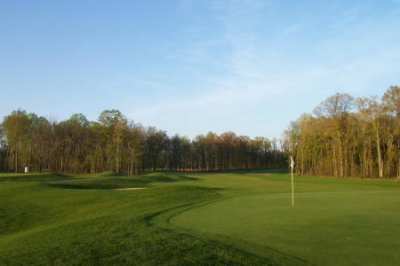 |
| The 16th hole is the last of the long par fours, but at 463 yards, you'll be hard pressed to make a par here. |
As far as the father-son working combination, Arthur had nothing but good things to say about his boy's role: "Joe was one of the best clients I've ever had (laughs). I really liked working with him on Blue Mash -- he has a great sense of design, and he did some things on his own that turned out very attractively. I think he has great feel for proportion and artistry in terms of architecture."
Joe, on the other hand, gives much credit to his Dad: "I particularly like the greens complexes on this course. I think that's what Dad does best, design very good, very interesting greens. There were a handful of greens that I worked on, but I pretty much worked from the plans that he'd drawn up. You'll see a lot of interesting work out there."
One note -- the Blue Mash 'odyssey' included a tough start, too. Opening up last year, the drought and this year's severe winter have brought up some conditioning issues on the course. Joe Hills readily admits that the greenery has not been what they would've wanted, but they'll get there: "We definitely had a tough time last year -- the lack of rain made it doubly hard for us trying to grow-in a brand new golf course. But I see things coming along now, and it gets better every day. The thin areas are filling in, and we're working on a lot of the rough edges right now. We've always received a lot of rave reviews on the conditions at Waverly Woods (Blue Mash's sister course, owned by the same group), and we'll do everything necessary to bring Blue Mash up to speed."
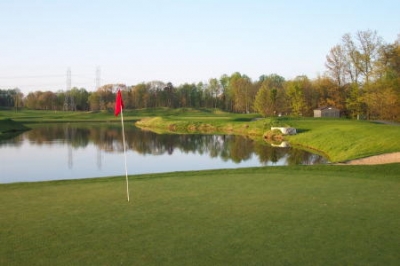 |
| Take it over the water to reach the 17th green -- but once you're there, your work's not finished on this tough green. |
Briefly looking at a few highlight holes, we particularly enjoyed number five, a 580 yard par five. Trees guard the entire left side, but the right side's plenty open (it parallels the third fairway). A group of bunkers and an elevated putting surface discourage the choice to go at it in two, but only a very small percentage of folks have the distance for a try at that, anyway. It's just a great, three-shot par five.
Eight is the potentially drive-able par four, 310 yards from the back tees. Joe Hills explained that the hole was designed to potentially tempt a try at driving it from each set of tees, but trouble abounds for an errant shot. There's always a very reasonable lay-up option for those who choose to leave the Titanium safely in the bag -- but from personal experience, it's a lot more fun to let fly and pay the consequences.
Twelve is another risk-reward hole, this time a 500 yard par five. From a somewhat elevated tee -- if there's a favorable wind, this could be your chance to grab a shot at eagle -- but if you miss to the right, you're wet, and left's no picnic either.
Seventeen's a fun par three (192 yards with a full water carry). Joe says it'll make or break your round: "I think seventeen's a really fun hole. It's almost always windy, and it's just a great accomplishment to hit the green on that hole. And once you're there, the putting surface is pretty darn tricky. It's a fun way to top off the day."
Though you probably won't grasp the difficulties that the owners went through to create Blue Mash Golf Course, you'll certainly appreciate the fun you'll have when you play there. As Arthur Hills said, it's a golf course for people to enjoy playing golf. And it might even foster the start of a new cliché -- force versus object equals fun.Details:
Blue Mash Golf Course
5821 Olney-Laytonsville Road
Laytonsville, MD 20882
Phone: (301) 670-1966
Website: www.bluemash.com
Course Designer: Arthur Hills
Owners & Managers: Joe Hills & Tom Healy
Radio Personality often sited at Blue Mash: Eric 'EB' Bickel
Tees | Yardage/Slope | Rating |
Gold | 6885/133 | 73.3 |
Blue | 6502/128 | 71.6 |
White | 6001/124 | 69.0 |
Red | 4966/113 | 68.9 |
Rates:
Mon - Thurs: $48 (walk), $58 (cart); 9 holes, $32/$38; twilight $34/$40; super twilight $24/$30; Seniors $38/$48; Juniors $20/$30.
Fri - Sun: $62 (walk), $72 (cart); Back 9, $34/$40; twilight $44/$50; super twilight $33/$39.
Fee for range balls. The course is very walker-friendly.
| Related Links | Comments on this article? | |
|
Maryland National Golf Club Hollow Creek Golf Club Rocky Gap Resort PB Dye Golf Club in Ijamsville Whiskey Creek Golf Club |
E-mail Jeff Rendall, Editor: jrendall@golftheunitedstates.com |











